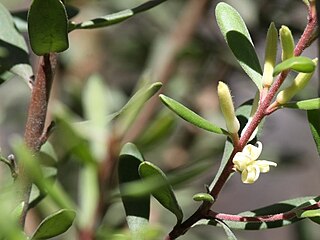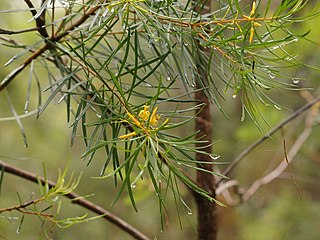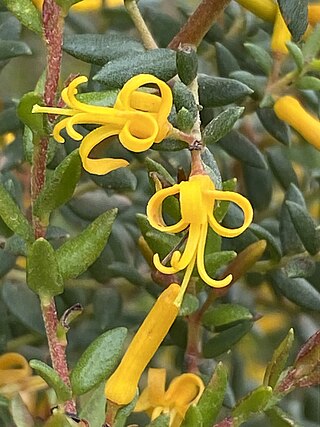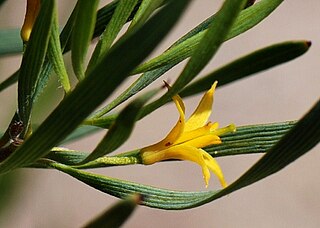Persoonia micranthera, commonly known as the small-flowered snottygobble, is a species of flowering plant in the family Proteaceae and is endemic to a restricted area in the south-west of Western Australia. It is a low-lying to prostrate shrub with branchlets that are hairy when young, spatula-shaped to lance-shaped leaves with the narrower end towards the base, hairy yellow flowers borne in groups of four to fifteen, and smooth, oval fruit.

Persoonia rigida, commonly known as the rigid-, hairy- or stiff geebung, is a species of flowering plant in the family Proteaceae and is endemic to south-eastern Australia. It is an erect to low-lying shrub with hairy young branchlets, lance-shaped to spatula-shaped leaves that are hairy when young, and yellow flowers borne in groups of up to twenty on a rachis up to 90 mm (3.5 in) long that continues to grow after flowering.

Persoonia subvelutina, commonly known as velvety geebung, is a plant in the family Proteaceae and is endemic to south-eastern Australia. It is a spreading to small tree with branchlets that are hairy when young, elliptic, lance-shaped, egg-shaped or spatula-shaped leaves and yellow flowers arranged singly in leaf axils on a pedicel 1–4 mm (0.039–0.157 in) long.

Persoonia glaucescens, commonly known as the Mittagong geebung, is a species of flowering plant in the family Proteaceae and is endemic to New South Wales. It is an erect shrub with smooth bark, hairy young branchlets, lance-shaped leaves with the narrower end towards the base, and yellow flowers. It is the only persoonia in eastern Australia with strongly glaucous leaves.
Persoonia katerae is a plant in the family Proteaceae and is endemic to a small area on the coast of New South Wales. It is an erect shrub to small tree with smooth bark on the branches, narrow elliptic to lance-shaped leaves with the narrower end towards the base, and yellow flowers in groups of six to twenty-two on a rachis 30–160 mm (1.2–6.3 in) long.

Persoonia virgata is a species of flowering plant in the family Proteaceae and is endemic to coastal areas of eastern Australia. It is usually an erect shrub with smooth bark, hairy young branchlets, linear to narrow spatula-shaped leaves, and yellow flowers borne in groups of up to seventy-five on a rachis up to 230 mm (9.1 in) long that continues to grow after flowering.

Persoonia stradbrokensis is a species of flowering plant in the family Proteaceae and is endemic to eastern Australia. It is an erect shrub or tree with hairy young branchlets, elliptic to egg-shaped leaves, and yellow flowers borne in groups of up to twenty on a rachis up to 100 mm (3.9 in), each flower with a leaf or scale leaf at its base.

Persoonia mollis, commonly known as soft geebung, is a plant in the family Proteaceae and is endemic to New South Wales. It is an erect to prostrate shrub with linear to oblong or spatula-shaped leaves, yellow flowers in groups of up to thirty on a rachis up to 150 mm (5.9 in) long and relatively small fruit.

Persoonia conjuncta is a species of flowering plant in the family Lamiaceae and is endemic to eastern New South Wales. It is an erect shrub or small tree with narrow elliptic to lance-shaped leaves, yellow, tube-shaped flowers in groups of up to sixteen and green fruit.

Persoonia adenantha is a plant in the family Proteaceae and is endemic to eastern Australia. It is an upright shrub or small tree with smooth, elliptic to lance-shaped leaves and groups of hairy yellow flowers. It has sometimes been confused with P. cornifolia and P. stradbrokensis.

Persoonia brevirhachis is a species of flowering plant in the family Proteaceae and is endemic to the south-west of Western Australia. It is an erect, often spreading shrub with smooth, compact bark, mostly narrow spatula-shaped to lance-shaped leaves with the narrower end towards the base and yellow to greenish yellow flowers borne singly or in pairs in leaf axils.

Persoonia daphnoides is a plant in the family Proteaceae and is endemic to a restricted area in eastern Australia. It is a prostrate shrub with spatula-shaped to egg-shaped leaves with the narrower end towards the base, and yellow flowers in groups of up to eight on a rachis up to 35 mm (1.4 in) long.

Persoonia cuspidifera is a species of flowering plant in the family Proteaceae and is endemic to northern New South Wales. It is an erect shrub with spatula-shaped leaves and greenish yellow, tube-shaped flowers in groups of up to twenty-five.
Persoonia spathulata is a species of flowering plant in the family Proteaceae and is endemic to the south-west of Western Australia. It is an erect to spreading shrub with hairy young branchlets, spatula-shaped leaves, and yellow flowers arranged singly or in pairs on a rachis up to 2 mm (0.079 in) long that continues to grow after flowering.

Persoonia iogyna is a species of flowering plant in the family Proteaceae and is endemic to south-eastern Queensland. It is an erect shrub or small tree with hairy young branchlets, narrow elliptical to lance-shaped leaves, yellow flowers and green fruit.
Persoonia tropica is a plant in the family Proteaceae and is endemic to north Queensland. It is an erect shrub to small tree shrub with branchlets that are hairy when young, narrow elliptic to lance-shaped leaves and yellow flowers in groups of three to ten on a rachis 3–10 mm (0.12–0.39 in) long that continues to grow after flowering.

Persoonia trinervis is a species of flowering plant in the family Proteaceae and is endemic to the south-west of Western Australia. It is an erect, sometimes spreading shrub with densely hairy young branchlets, spatula-shaped or lance-shaped leaves with the narrower end towards the base, and densely hairy yellow flowers.

Persoonia quinquenervis is a species of flowering plant in the family Proteaceae and is endemic to the south-west of Western Australia. It is an erect, spreading shrub with hairy young branchlets, twisted linear, lance-shaped, narrow oblong or narrow spatula-shaped leaves, and bright yellow flowers borne in groups of up to ten on a rachis up to 60 mm (2.4 in) that continues to grow after flowering.
Persoonia brachystylis is a species of flowering plant in the family Proteaceae and is endemic to a restricted area on the west coast of Western Australia. It is an erect, spreading shrub with smooth bark, narrow spatula-shaped to lance-shaped leaves and yellow flowers in groups of ten to twenty.

Persoonia comata is a species of flowering plant in the family Proteaceae and is endemic to the south-west of Western Australia. It is an erect, sometimes spreading to low-lying shrub with mostly smooth bark, spatula-shaped to lance-shaped leaves with the narrower end towards the base and yellow flowers usually in groups of ten to fifty along a rachis up to 250 mm (9.8 in) long.
















